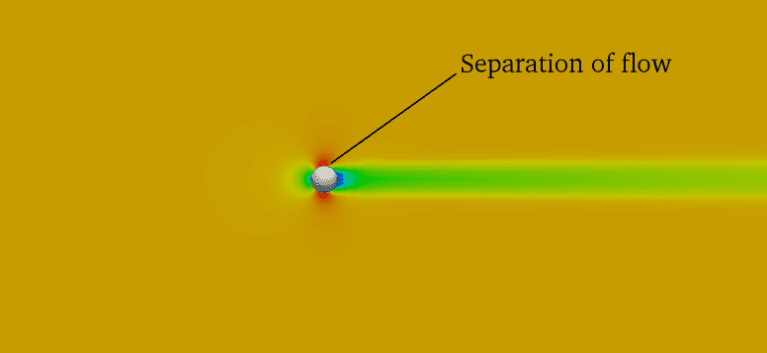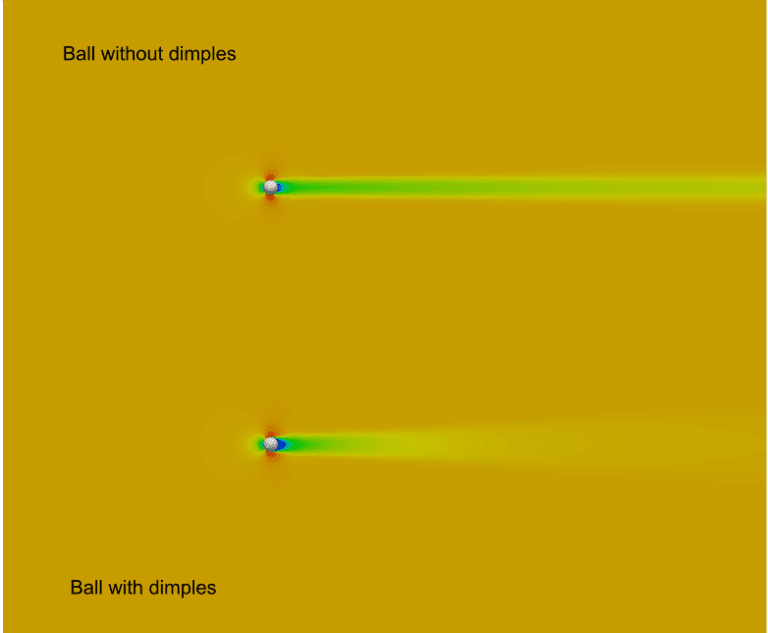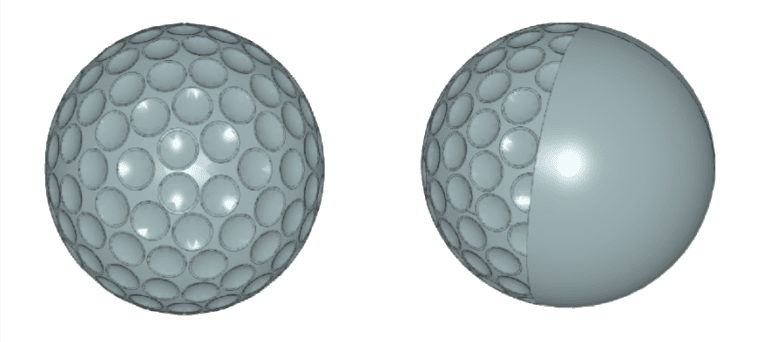A conversation in the early 1900s:
Tom: Jerry, I’m entering the golf course. Feel free to join me.
I should select the smoothest possible ball from the basket. Oops! There is only one unused left. Let me use the last one.
Jerry: That’s so mean! I don’t have a choice.

Everybody prefers to play with a brand new ball. The notion is that smoother balls have less resistance to travel through air, hence travels a longer distance. At the end of round 1:
Tom: What just happened? In principle, the ball I hit should have traveled a longer distance, which isn’t the case.
This was the idea behind having irregularities or “simples” in a golf ball. Since then, a lot of research has gone into this to discover the perfect combination of the irregularities.
Yes, you read it right, the perfect combination (symmetry) for the irregularity.
Golf Ball Aerodynamics: Dimples and Fluid Dynamics
Golf ball dimples and their impact on the ball traveling through the air can be described using fluid dynamics.
Basically, there are two types of fluid dynamic flows: laminar and turbulent. In general, many real-life applications are turbulent in nature. This can generally be obtained from a factor called Reynolds number. In the current scenario, when the ball is smooth, it gives rise to something close to a laminar flow. In this case, the fluid flow downstream detaches from the surface of the ball in the form of vortices. This phenomenon is called flow separation, which gives rise to a viscous wake behind the ball that slows it down.

What do golf ball dimples do? The dimples act as artificial turbulators, creating turbulence next to the ball surface and creating two layers of air going around the ball. The top layer is going faster than the bottom layer, i.e., air clings to the ball’s surface, which creates turbulence. This reduces the drag and helps the ball to travel farther than a smooth one. This is another new term: drag. Drag is a force component which arises as a result of a difference in velocity of a solid and fluid body, and it opposes the solid motion through the air—in this case, the golf ball. A dimpled golf ball probably only has about half the drag of a smooth one. Now back to our story; the reduction of drag allows the flight of the golf ball to be faster due to the decreased resistance.

Similar to drag, there is another component called “lift”. Lift occurs when the fluid is turned by the solid, which creates an opposing force. If the ball spins in a way that pushes the air downward, then an upward lift force is experienced by the ball. One important thing to note is that this factor comes into play only when the ball is spinning. Why? The spinning action makes the air pressure on the bottom of the ball higher than the air pressure on the top, and this imbalance creates an upward force on the ball. Ball spin contributes to half of a golf ball’s lift. The other half of lift is provided by the golf ball dimples, which allows for optimization of the lift force.
Let’s discuss golf ball aerodynamics in more detail. When the ball spins around an axis perpendicular to the plane in which it travels, we experience lift. What if the spin is around any of the other two axes? That’s the world famous Roberto Carlos or Beckham’s rocket kick in football. The ball gets to travel in a projectile, and this effect is called the “Magnus effect“. A similar effect can be seen in the game of cricket when a fast bowler tries to swing the ball.
The number of dimples on the golf ball is usually between 330 and 500. Golf balls are usually covered with dimples in a highly symmetrical way. The ball will wobble if it’s not symmetrical, or its flight will depend on which part of the ball faces forwards or sideways as the ball spins.
Assume that there are dimples on only one side of the ball. The ball tends to curve towards the side with the dimples since the wake is generated towards the side which is smooth. For example, if the ball shown in the below figure is being hit along the same viewing direction, it will travel towards the left.
I hope this article was useful in understanding golf ball aerodynamics and the impact of fluid dynamics in sports. If you’d like to try a simulation by yourself, you can create a free SimScale account and start an analysis in just a few minutes. It works 100% in the cloud, so no hardware or installation is needed.
SimScale’s CEO David Heiny tests the capabilities of the platform to solve a real-life engineering problem. Fill in the form and watch this free webinar to learn more!
References
- https://www.grc.nasa.gov/www/k-12/airplane/socdrag.html



